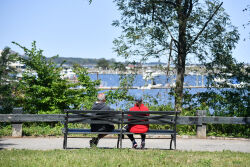Bicentennial Veterans Memorial Park
Bicentennial Veterans Memorial Park
This park honors the men and women who have preserved, protected, and America’s armed forces throughout its history.
In 1917, the United States entered World War I (1914-1918), a brutal conflict that took the lives of 116,000 Americans. Allied with France, England, and Russia against Germany and Austria, the presence of United States soldiers on the European battlefields shifted the war’s momentum in the Allies’ favor. On the eleventh hour, of the eleventh day, of the eleventh month of 1918, all of the participating nations signed an armistice ending the war.
A year later, on the anniversary of that date in 1919, President Woodrow Wilson (1856-1924) declared Armistice Day a national holiday, the first recognized day of remembrance for soldiers. Armistice Day honored the veterans of World War I (1914-1918) until 1954, when President Dwight D. Eisenhower (1890-1969) expanded the narrow scope of the holiday to remember all American veterans, living or dead, renaming November 11 “Veterans Day.” The date was also declared a national holiday in England and France, and remains celebrated today in France, the United Kingdom and Canada, although it is called Remembrance Day in Canada, and Remembrance Sunday in the United Kingdom, where it is celebrated on the second Sunday of November.
The Throgs Neck property on which this park is located was once a waterway known as Weir Creek. The creek extended from the Long Island Sound as far north as Middleton Road and as far south as Lawton Avenue. The name Weir Creek was given to the waterway by early settlers after Native Americans taught them how to make fishing weirs using plaited reeds. The word “weir,” which originated in 9th century Old English, meant a block or dam in a waterway. Settlers used netted weirs at the mouth of the creek for many years, but the rapid urbanization of the area in the late 19th and early 20th centuries spelled doom for the once rural creek. The construction of neighborhood streets, major highway construction, and the development of residential areas led to the gradual filling in of Weir Creek by the late 1950s.
The City acquired this site in June 1957, in conjunction with the continuing construction of the Throgs Neck and Cross-Bronx Expressways. The park remained unnamed until a 1959 local law named it Weir Creek to honor the Native American tradition in the area.
In May of 1976, New York City Mayor Abraham Beame (1906-2001) renamed this property Bicentennial Veterans Memorial Park to honor the 200th anniversary of the American Revolution (1776-1783) and the veterans who have faithfully served to defend their country throughout America’s history. The scenic park includes a pair of baseball fields, sloping hills, open fields, a series of walkways, a flagpole with a yardarm, and a stone monument. From the edge of the park one can look out past Weir Creek for a view of City Island. Council Member Lucy Cruz funded a $23,000 repair of the park’s fences and guide rails in 1997.
Check out your park's Vital Signs
Clean & Safe
Green & Resilient
Empowered & Engaged Users
Share your feedback or learn more about how this park is part of a
Vital Park System










